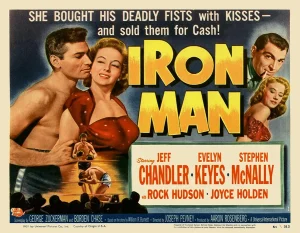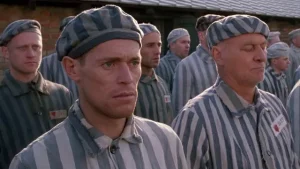
What Is Ong-Bak: Muay Thai Warrior (2003) About?
“Ong-Bak: Muay Thai Warrior” is a Thai martial arts film released in 2003, directed by Prachya Pinkaew and starring Tony Jaa. The film follows the story of Ting, a young man from a rural Thai village, who embarks on a journey to recover the stolen head of his village’s sacred Buddha statue, Ong-Bak. The statue’s head is stolen by a group of criminals who intend to sell it for a hefty profit.
Ting travels to Bangkok, where he uses his exceptional skills in the martial art of Muay Thai to confront the criminals and retrieve the stolen artifact. Along the way, he encounters various challenges and adversaries, showcasing his impressive fighting abilities in a series of intense and exhilarating action sequences.
The film gained widespread acclaim for its stunning choreography, particularly the skillful Muay Thai fight scenes performed by Tony Jaa, who emerged as a breakout star in the world of martial arts cinema. “Ong-Bak: Muay Thai Warrior” helped to popularize Thai martial arts and established Tony Jaa as one of the genre’s most talented and exciting performers.
| Title | Ong-Bak: Muay Thai Warrior |
|---|---|
| Release Year | 2003 |
| Director | Prachya Pinkaew |
| Lead Actor | Tony Jaa |
| Genre | Action, Martial Arts |
| Setting | Thailand |
| Plot Summary | Ting, a young man from a rural Thai village, seeks to recover the stolen head of his village’s sacred Buddha statue, Ong-Bak, which has been taken by a group of criminals intending to sell it for profit. Ting travels to Bangkok and uses his exceptional skills in Muay Thai to confront the criminals and retrieve the stolen artifact. Along the way, he encounters various challenges and adversaries, showcasing his impressive fighting abilities in a series of intense action sequences. |
| Reception | The film gained widespread acclaim for its stunning choreography, particularly the skillful Muay Thai fight scenes performed by Tony Jaa. It helped popularize Thai martial arts and established Tony Jaa as one of the genre’s most talented performers. |
What Is the Plot of the Movie?
“Ong-Bak: Muay Thai Warrior” is a gripping tale set in rural Thailand, revolving around Ting, a young man raised in the peaceful village of Nong Pradu. The heart of the village is the sacred Buddha statue, Ong-Bak, revered by the locals for its spiritual significance. However, when the head of Ong-Bak is stolen by ruthless thieves, it threatens the very soul of the village. Ting, portrayed by the remarkable Tony Jaa, embarks on a perilous journey to retrieve the stolen relic and restore peace to his community.
The film begins with Ting, a skilled practitioner of Muay Thai, being chosen by the village elders to travel to Bangkok, the bustling capital of Thailand, to recover Ong-Bak’s head. Ting, embodying the values of humility and courage, accepts the challenge with unwavering determination. Accompanied by his childhood friend and loyal companion, George, Ting sets out on his quest, leaving behind the tranquil simplicity of rural life for the chaotic urban landscape of Bangkok.
Upon their arrival in the sprawling metropolis, Ting and George quickly find themselves immersed in a world of crime and corruption. They encounter various characters, from street hustlers to underground fighters, each with their own motives and agendas. Ting’s pure-heartedness and commitment to his mission contrast sharply with the moral ambiguity of the city’s underworld, setting the stage for a clash of values and ideologies.
As Ting delves deeper into the heart of Bangkok’s criminal underworld, he discovers that the theft of Ong-Bak’s head is part of a larger conspiracy orchestrated by a powerful crime lord named Khom Tuan. Khom Tuan, driven by greed and a thirst for power, seeks to exploit the sacred relic for financial gain, regardless of the consequences for Ting’s village or the sanctity of their traditions.
Undeterred by the dangers that lie ahead, Ting embarks on a series of thrilling adventures and confrontations as he navigates the treacherous landscape of Bangkok. With his exceptional skills in Muay Thai, Ting proves to be a formidable opponent against Khom Tuan’s henchmen, dispatching them with precision and grace in electrifying fight sequences that showcase Tony Jaa’s extraordinary martial arts prowess.
Throughout his journey, Ting remains steadfast in his commitment to honor and integrity, embodying the principles of traditional Thai culture in the face of modern-day challenges. His resilience and unwavering faith in the righteousness of his cause inspire those around him, earning him allies among the downtrodden and marginalized members of society.
Ultimately, Ting confronts Khom Tuan in a climactic showdown, pitting his martial arts expertise against the villain’s formidable forces in a battle for the soul of Ong-Bak and the fate of his village. In a dazzling display of skill and determination, Ting emerges victorious, reclaiming the stolen head of the sacred Buddha statue and restoring peace to Nong Pradu.
“Ong-Bak: Muay Thai Warrior” is more than just a martial arts film; it is a timeless tale of courage, sacrifice, and the enduring power of tradition in the face of modernization and greed. Through the character of Ting, portrayed with depth and authenticity by Tony Jaa, the film celebrates the rich cultural heritage of Thailand and the indomitable spirit of its people.
Reasons to Watch It
“Ong-Bak: Muay Thai Warrior” offers audiences a captivating cinematic experience with several compelling reasons to watch:
- Tony Jaa’s Phenomenal Martial Arts Skills:
- Tony Jaa’s breathtaking performance as Ting showcases his extraordinary talent in Muay Thai, captivating viewers with his lightning-fast strikes, acrobatic maneuvers, and impeccable technique. His mastery of the martial art form elevates the film’s action sequences to unparalleled heights, making it a must-watch for fans of martial arts cinema.
- Authentic Thai Culture and Setting:
- The film provides an immersive glimpse into Thailand’s rich cultural heritage, from its picturesque rural landscapes to the vibrant streets of Bangkok. Through its authentic portrayal of Thai customs, traditions, and beliefs, “Ong-Bak” offers audiences a deeper appreciation for the country’s cultural identity and traditions.
- Visually Stunning Action Sequences:
- Director Prachya Pinkaew’s expert direction and choreography bring the film’s action sequences to life with visceral intensity and jaw-dropping stunts. From exhilarating chase scenes through bustling marketplaces to adrenaline-fueled fights in underground arenas, “Ong-Bak” delivers non-stop thrills and excitement from start to finish.
- Compelling Storyline and Characters:
- Beyond its adrenaline-pumping action, “Ong-Bak” features a compelling storyline centered around Ting’s quest to reclaim the stolen head of the sacred Buddha statue. Ting’s journey is filled with twists, turns, and moral dilemmas, as he confronts corruption, greed, and betrayal while remaining true to his principles and values.
- Cinematic Influence and Legacy:
- “Ong-Bak: Muay Thai Warrior” has left an indelible mark on the world of martial arts cinema, inspiring a new generation of filmmakers and performers. Its innovative choreography, dynamic fight scenes, and authentic representation of Thai culture have earned it a place among the genre’s most influential and iconic films.
Overall, “Ong-Bak: Muay Thai Warrior” is a thrilling cinematic experience that combines heart-pounding action, compelling storytelling, and authentic cultural representation, making it a must-watch for fans of martial arts and action cinema alike.
Is the Movie a Real or Fictional Story?
“Ong-Bak: Muay Thai Warrior” is a fictional story. While the film is set in real locations in Thailand and incorporates elements of Thai culture and martial arts, the specific events, characters, and plotlines are all products of the filmmakers’ imagination. The story revolves around the theft of a sacred Buddha statue’s head and the protagonist’s journey to recover it, which is entirely fictional. However, the film’s portrayal of Muay Thai and its cultural context draws from real traditions and practices in Thailand.
Is It Critically Panned or Acclaimed?
“Ong-Bak: Muay Thai Warrior” received generally positive reviews from critics and audiences alike upon its release. While it may not have achieved widespread acclaim from mainstream Western critics, it garnered significant praise within the martial arts and action cinema community for its stunning fight choreography, Tony Jaa’s impressive performance, and its authentic representation of Thai culture.
Critics praised the film’s electrifying action sequences, with many highlighting Tony Jaa’s exceptional martial arts skills and the innovative choreography by director Prachya Pinkaew. Additionally, the film’s portrayal of traditional Thai customs and values resonated with audiences, contributing to its appeal.
Overall, while “Ong-Bak: Muay Thai Warrior” may not have been universally acclaimed by all critics, it remains highly regarded within its genre and has earned a dedicated fanbase for its exhilarating action and cultural authenticity.
| Aspect | Description |
|---|---|
| Critical Reception | Generally positive reviews from audiences and within the martial arts community. |
| Main Highlights | Stunning fight choreography, Tony Jaa’s exceptional performance, authentic Thai culture portrayal. |
| Audience Reception | Well-received by fans of martial arts and action cinema. |
| Legacy | Cemented as a significant film within the martial arts genre, inspiring future filmmakers and performers. |
| Awards | While it didn’t win major awards, it gained recognition in the action and martial arts film circuits. |
| Cultural Impact | Helped popularize Thai martial arts and showcased Thai culture to international audiences. |
| Box Office Performance | Successful commercially, especially considering its modest budget. |
What Does the Movie Explore?
“Ong-Bak: Muay Thai Warrior” explores several themes and elements throughout its narrative:
- Tradition vs. Modernity:
- The film juxtaposes traditional Thai values and customs against the backdrop of modern urban life. Ting’s journey from his rural village to the bustling streets of Bangkok highlights the clash between traditional beliefs and the influence of contemporary society.
- Corruption and Greed:
- Through the character of Khom Tuan and his associates, the film delves into themes of corruption and greed. Khom Tuan’s willingness to exploit sacred relics for personal gain reflects a broader commentary on the corrupting influence of power and wealth.
- Identity and Cultural Heritage:
- “Ong-Bak” celebrates Thai culture and heritage, showcasing traditional rituals, customs, and martial arts practices. Ting’s quest to reclaim the stolen head of the Buddha statue represents a deeper connection to his cultural identity and the preservation of Thai traditions.
- Courage and Resilience:
- The protagonist, Ting, exemplifies courage and resilience in the face of adversity. Despite encountering numerous challenges and obstacles, Ting remains steadfast in his mission to retrieve Ong-Bak’s head, demonstrating the importance of perseverance and determination.
- Justice and Redemption:
- The film explores themes of justice and redemption as Ting seeks to right the wrongs committed against his village and restore peace to his community. Ting’s pursuit of justice reflects a desire to uphold moral principles and rectify injustice.
Overall, “Ong-Bak: Muay Thai Warrior” is more than just a martial arts action film; it delves into deeper themes and issues, offering audiences a thought-provoking exploration of tradition, identity, and the human spirit.
Memorable Moments in the Movie
“Ong-Bak: Muay Thai Warrior” is filled with memorable moments that captivate audiences with their intensity, creativity, and adrenaline-pumping action. Here are some of the most memorable scenes from the film:
- Opening Fight Scene:
- The film kicks off with a thrilling showcase of Ting’s martial arts skills as he competes in a traditional Muay Thai tournament in his village. This scene establishes Ting as a formidable fighter and sets the stage for the action-packed journey ahead.
- Chase Through the Market:
- Ting engages in a high-octane pursuit through a crowded marketplace in Bangkok, evading his pursuers with agility and finesse. The scene is filled with narrow escapes, impressive stunts, and heart-pounding moments that keep viewers on the edge of their seats.
- Fight in the Underground Arena:
- Ting enters an underground fighting arena, where he must battle a series of opponents in brutal hand-to-hand combat. The scene features intense fight choreography, showcasing Tony Jaa’s exceptional martial arts skills as he takes on multiple adversaries with speed and precision.
- Temple Showdown:
- The climactic showdown between Ting and the main antagonist, Khom Tuan, takes place in a temple filled with ancient artifacts. The scene is a culmination of tension and suspense, as Ting confronts Khom Tuan in a fierce battle that tests his strength, skill, and determination.
- Final Chase Scene:
- The film concludes with a thrilling chase sequence as Ting pursues the fleeing criminals through the streets of Bangkok. The chase is filled with adrenaline-fueled moments, daring leaps, and narrow escapes, culminating in a satisfying resolution to Ting’s quest.
These memorable moments, along with many others throughout the film, contribute to the exhilarating and unforgettable experience of “Ong-Bak: Muay Thai Warrior.”
Streaming Platforms to Watch the Movie From
“Ong-Bak: Muay Thai Warrior” may be available for streaming on various platforms depending on your region. Here are some popular streaming platforms where you might find the movie:
- Netflix:
- Netflix often features a diverse selection of films, including martial arts movies. “Ong-Bak: Muay Thai Warrior” may be available for streaming on Netflix in certain regions.
- Amazon Prime Video:
- Amazon Prime Video frequently offers a wide range of movies for streaming, including international titles. You may find “Ong-Bak: Muay Thai Warrior” available for rent or purchase on Amazon Prime Video.
- iTunes/Apple TV:
- You can rent or purchase digital copies of “Ong-Bak: Muay Thai Warrior” through the iTunes Store or Apple TV app.
- Google Play Movies & TV:
- Google Play Movies & TV often offers a selection of movies for rental or purchase, including “Ong-Bak: Muay Thai Warrior.”
- YouTube Movies:
- You might find “Ong-Bak: Muay Thai Warrior” available for rental or purchase on YouTube Movies.
- Vudu:
- Vudu is another platform where you can rent or purchase digital copies of movies, including “Ong-Bak: Muay Thai Warrior.”
- Hulu:
- While Hulu primarily focuses on TV shows, it occasionally offers a selection of movies. “Ong-Bak: Muay Thai Warrior” may be available for streaming on Hulu in certain regions.
Please note that availability may vary depending on your location, and licensing agreements may change over time. It’s always a good idea to check the specific streaming platforms available in your region for the most up-to-date information on where to watch “Ong-Bak: Muay Thai Warrior.”






